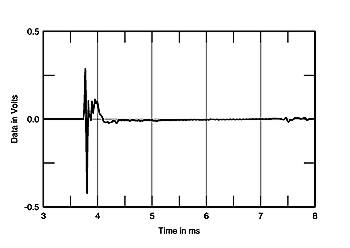| Columns Retired Columns & Blogs |
Measuring Loudspeakers, Part Two Page 2
An analogy can be drawn with the Heisenberg Uncertainty Principle: the more tightly you confine something in one domain, the more uncertain it becomes in an alternate domain. If you confine the rectangular pulse in the time domain to an infinitely narrow time, its spectrum in the frequency domain becomes infinite. Conversely, if you confine the frequency-domain representation of a signal, its spectrum, to a single line—ie, there is just one frequency present—the time-domain representation of the signal extends from the beginning of all time to the end of all time.
A typical loudspeaker's impulse response is shown in fig.9, this acquired with a 30kHz bandwidth and with the MLSSA system's antialiasing filter set to a Thomson low-pass function, which doesn't ring. The sharp up-spike and down-spike is the tweeter's output, followed by lower-frequency information, a few ripples and reflections of the sound wave from the speaker's baffle and cabinet, and finally the reflections of the sound from the room boundaries starting at the 7.5ms mark. An impulse response is extremely hard to interpret, not least because, with a loudspeaker, it is visually dominated by the tweeter's output. Its shape doesn't really tell you much in itself about woofer and midrange-unit behavior. It is also important to note that the impulse response and any information derived from it are only relevant to the loudspeaker's output at the specific microphone position used to capture it.

Fig.9 Typical loudspeaker impulse response.
What I have found more useful as a diagnostic tool is the speaker's step response. Instead of driving the loudspeaker with a single rectangular pulse, you feed it a voltage which instantaneously rises from zero to a positive value and stays there (fig.10). This has practical certain problems, so I use the MLSSA software to calculate a loudspeaker's step response from its impulse response. A plot of the step response appears to give more-or-less equal visual weighting to the outputs of all of a speaker's drive-units. You can now glean a lot more information about the lower-frequency drivers, as well as getting a good idea of how time-coherent the speaker is.

Fig.10 Perfect step response.
The acoustic pressure in a speaker's step response cannot rise instantaneously because the risetime is limited by the tweeter's restricted ultrasonic response. But as long as the speaker has a bandwidth greater than the upper audio limit of 20kHz, the difference in risetime is trivial. More importantly, because a loudspeaker cannot reproduce the acoustic equivalent of a DC voltage—all loudspeakers can be modeled as a high-pass filter of some kind—the sound decays back to the time axis in an exponential manner. It always crosses that axis but eventually returns to it so that the areas on both sides of the time axis are equal, ensuring that there is no DC component present. An ideal step response should therefore resemble a slightly concave right triangle.
- Log in or register to post comments




































